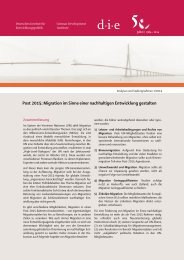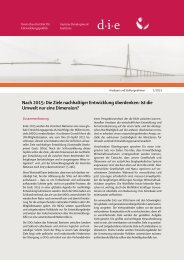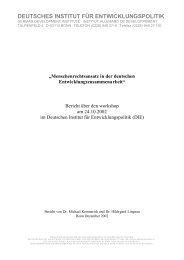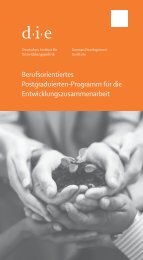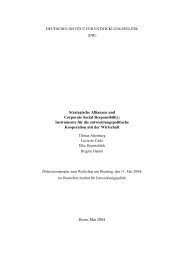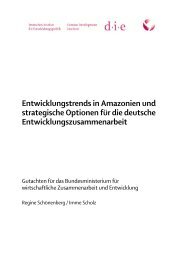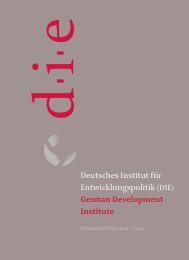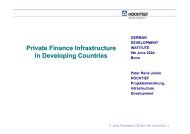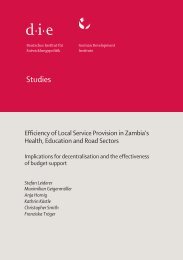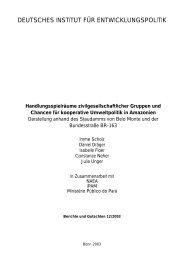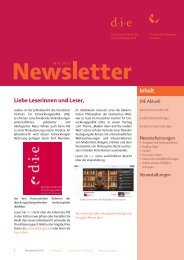Middle East / North Africa and the Millennium Development Goals ...
Middle East / North Africa and the Millennium Development Goals ...
Middle East / North Africa and the Millennium Development Goals ...
You also want an ePaper? Increase the reach of your titles
YUMPU automatically turns print PDFs into web optimized ePapers that Google loves.
(Overview 1: The MDGs, with targets <strong>and</strong> indicators, continued)<br />
<strong>Goals</strong> <strong>and</strong> targets<br />
Target 10: Halve, by 2015,<br />
<strong>the</strong> proportion of<br />
people without<br />
sustainable<br />
access to safe<br />
drinking water<br />
<strong>and</strong> sanitation<br />
Target 11: By 2020, to have<br />
achieved a<br />
significant<br />
improvement<br />
in <strong>the</strong> lives of at<br />
least 100 million<br />
slum dwellers<br />
20<br />
Markus Loewe<br />
Indicators<br />
(with <strong>the</strong> international organization/s<br />
responsible for collecting <strong>the</strong> statistical data)<br />
30. Proportion of population with sustainable<br />
access to an improved water source:<br />
(a) urban <strong>and</strong> (b) rural (UNICEF / WHO)<br />
31. Proportion of population with access to<br />
improved sanitation: (a) urban <strong>and</strong><br />
(b) rural (UNICEF / WHO)<br />
(indicator included 2002 during Johannesburg<br />
Summit on Sustainable <strong>Development</strong>)<br />
32. Proportion of households with access to<br />
secure tenure (UN-HABITAT)<br />
Goal 8: Develop a global partnership for development<br />
Target 12: Develop fur<strong>the</strong>r<br />
an open, rulebased,predictable,nondiscriminatory<br />
trading <strong>and</strong><br />
financial system.<br />
(Includes a<br />
commitment to<br />
good governance,<br />
development<br />
<strong>and</strong> poverty<br />
reduction – both<br />
nationally <strong>and</strong> internationally)<br />
Target 13: Address <strong>the</strong> special<br />
needs of <strong>the</strong><br />
LDCs<br />
(Includes tariff<br />
<strong>and</strong> quota-free<br />
access for LDCs<br />
exports;<br />
Some of <strong>the</strong> indicators listed below are<br />
monitored separately for <strong>the</strong> least developed<br />
countries (LDCs), <strong>Africa</strong>, l<strong>and</strong>locked<br />
developing countries (LLDCs)<br />
Official development assistance (ODA):<br />
33. Net ODA, (a) total <strong>and</strong> (b) to LDCs, as<br />
percentage of OECD / <strong>Development</strong> Assistance<br />
Committee (DAC) donors’ gross national<br />
income (GNI) (OECD)<br />
34. Proportion of total bilateral, sectorallocable<br />
ODA of OECD/DAC donors to<br />
basic social services (basic education,<br />
primary health care, nutrition, safe water<br />
<strong>and</strong> sanitation) (OECD)<br />
35. Proportion of bilateral ODA of<br />
OECD/DAC donors that is untied (OECD)<br />
36. ODA received in l<strong>and</strong>locked developing<br />
countries as a proportion of <strong>the</strong>ir GNIs<br />
(OECD)<br />
37. ODA received in small isl<strong>and</strong> developing<br />
States as proportion of <strong>the</strong>ir GNIs (OECD)<br />
German <strong>Development</strong> Institute



